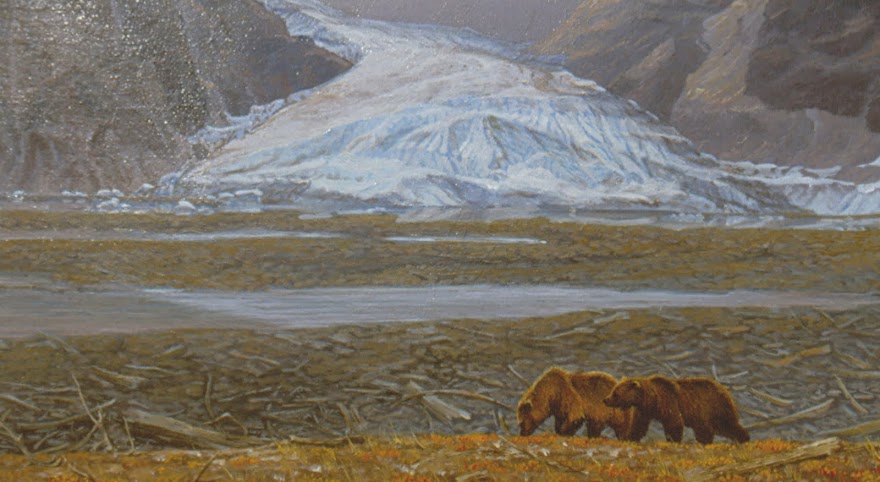The story goes something like this. Back in 1908, some gold prospectors were sitting around in a bar in the tiny outpost of Seward, Alaska. They looked up at Mt. Marothon, looming above them and started betting about which of them could climb up to the summit and back the fastest. The photo above is not actually Mt. Marathon, but it is nearby.
A view of Resurrection river as it flows down toward Seward, and Resurrection bay. It is fed by Exit Glacier.
Now back to the story of Mt. Marathon. In the photo above, Mt. Marathon is the large mountain that dominates the upper right hand portion of the scene. It is steep, and rises well above timberline which is only about 500 feet in elevation, as you can see in the photo.
The original gold panners somehow clawed their way to the top and back without losing a single person. The Great Mt. Marathon Race was born.
The Mt. Marathon race is the second oldest footrace in the country. It starts in downtown Seward on July 4th every year. This is the view of the top from town.
This is the top using my camera's full 30x zoom. you can see the tracks of previous climbers and two people at the top. On race day, this place is a madhouse. People struggle uphill, and tumble downhill. Many people are injured every year. I could never hope to be fit enough to climb such a steep hill at my age. In my youth this would have been an irresistable challenge, had I been in Alaska.
So, how long do you suppose it would take for the fastest runners to climb up and back? Take a guess. Amazingly, the fittest racers get to the top and back in about 45 minutes. That's quite a feat.
A Bald Eagle and Glaucous-winged Gulls near Seward from my trip there last week.
I got so many photos of the immature Bald Eagle last week. So I'll add a few more photos of that cooperative bird.
I wonder if the the concealing tuft of beach grass gave the young eagle a sense of security? Maybe that is why it allowed such a close approach.
Mid blink with blue eyelids. It appears to me that the eagle blinks using it's lower eyelid that rises to cover the eye.
Back in Arizona I listened to a presentation given by a local photographer who specialized in photographing Bald Eagles. The local Arizona eagles were so wary that it was difficult to approach them within 100 yards, (meters). He told stories of climbing into winter blinds, (hides) before dawn, shivering all day to get a few acceptable photos, and leaving the blind after dark.
He also spent a lot of money buying remote control shutter releases, and movable tripods etc. I wonder what he would think about situations like this? Where some fool like myself can just walk up and get close portraits of wild eagles. Even with my cheap camera, my eagle photos put his to shame.
One last look at a sailboat on Resurrection Bay.
A view of Resurrection river as it flows down toward Seward, and Resurrection bay. It is fed by Exit Glacier.
Now back to the story of Mt. Marathon. In the photo above, Mt. Marathon is the large mountain that dominates the upper right hand portion of the scene. It is steep, and rises well above timberline which is only about 500 feet in elevation, as you can see in the photo.
The original gold panners somehow clawed their way to the top and back without losing a single person. The Great Mt. Marathon Race was born.
The Mt. Marathon race is the second oldest footrace in the country. It starts in downtown Seward on July 4th every year. This is the view of the top from town.
This is the top using my camera's full 30x zoom. you can see the tracks of previous climbers and two people at the top. On race day, this place is a madhouse. People struggle uphill, and tumble downhill. Many people are injured every year. I could never hope to be fit enough to climb such a steep hill at my age. In my youth this would have been an irresistable challenge, had I been in Alaska.
So, how long do you suppose it would take for the fastest runners to climb up and back? Take a guess. Amazingly, the fittest racers get to the top and back in about 45 minutes. That's quite a feat.
A Bald Eagle and Glaucous-winged Gulls near Seward from my trip there last week.
I got so many photos of the immature Bald Eagle last week. So I'll add a few more photos of that cooperative bird.
I wonder if the the concealing tuft of beach grass gave the young eagle a sense of security? Maybe that is why it allowed such a close approach.
Mid blink with blue eyelids. It appears to me that the eagle blinks using it's lower eyelid that rises to cover the eye.
Back in Arizona I listened to a presentation given by a local photographer who specialized in photographing Bald Eagles. The local Arizona eagles were so wary that it was difficult to approach them within 100 yards, (meters). He told stories of climbing into winter blinds, (hides) before dawn, shivering all day to get a few acceptable photos, and leaving the blind after dark.
He also spent a lot of money buying remote control shutter releases, and movable tripods etc. I wonder what he would think about situations like this? Where some fool like myself can just walk up and get close portraits of wild eagles. Even with my cheap camera, my eagle photos put his to shame.
One last look at a sailboat on Resurrection Bay.






















